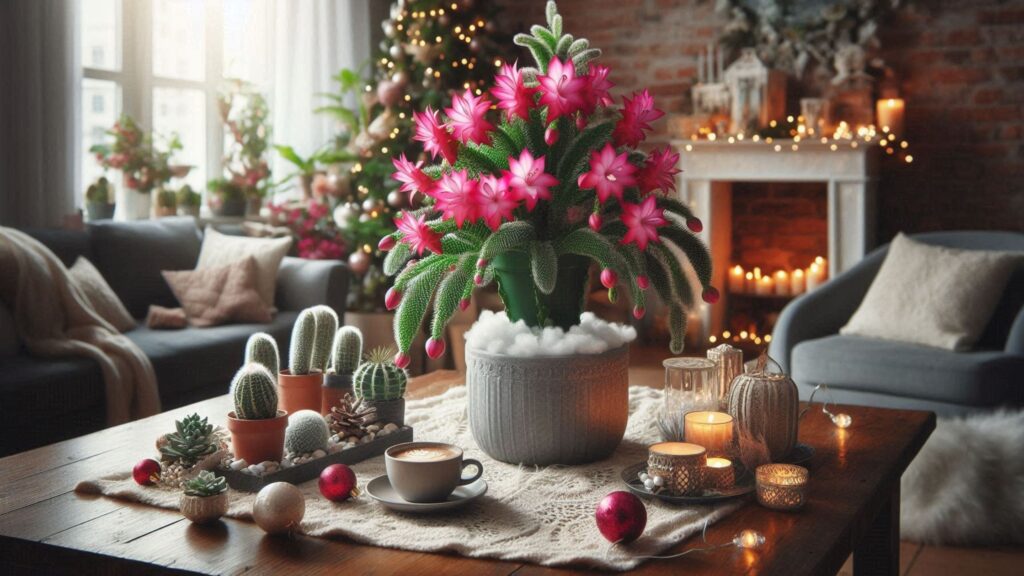The Christmas cactus (Schlumbergera x buckleyi) is a popular houseplant that blooms with vibrant flowers during the winter months, making it a festive addition to any home during the holiday season

Types of Christmas Cactus Plants
- Christmas Cactus
- Thanksgiving Cactus
- Easter Cactus
Benefits of Christmas Cactus Plant
Winter-Blooming: It’s a symbol of resilience, blooming in winter and adding color and hope during the holidays.
Thoughtful Gift: Represents generosity, heritage, and unity across cultures, making it a meaningful gift.
Air-Purifying: Known for its low maintenance and air-purifying qualities, it’s ideal for gardeners of all levels.
Symbolic Value: It’s associated with peace and joy, and its bright blooms represent harmony and bring a sense of luck into the home.
Health Benefits: Some cactus plants like the prickly pear may have medicinal benefits, providing antioxidants, and helping to lower cholesterol and regulate blood sugar levels.
Disadvantages of Christmas Cactus Plant
Susceptibility to Overwatering: Since they’re not your typical desert cacti, Christmas cacti don’t appreciate constantly soggy soil. Overwatering is a common mistake that can lead to root rot, a fungal disease that can be fatal to the plant.
Light Requirements Can Be Tricky: Christmas cacti need bright, indirect sunlight. Too much direct sun can scorch the leaves, while insufficient light can hinder flowering. Finding the right balance might take some trial and error depending on your home’s lighting conditions.
Specific Needs for Blooming: Unlike many houseplants that flower readily indoors, Christmas cacti have specific light and temperature requirements to trigger bud formation. This can involve providing them with shorter days and cooler nighttime temperatures during fall and winter to mimic their natural flowering season.
Potential for Pests and Diseases: While not super prone to pests and diseases, Christmas cacti can be susceptible to mealybugs, scale insects, and fungal diseases like botrytis blight if not cared for properly.
Seasonal Plant: The main appeal of the Christmas cactus is its festive winter blooms. Keep in mind that for most of the year, it’s a green, segmented plant that may not be as visually striking compared to other flowering houseplants.
Christmas Cactus Plant Car
Light: Provide bright but indirect light. Too much direct sunlight can stunt growth and burn the leaves.
Temperature: Keep it in a normal house temperature range, about 65 to 75°F (18 to 24°C). Cooler night temperatures can help initiate blooming.
Watering: Water moderately, allowing the soil to partially dry between waterings. Over-watering can lead to root rot.
Humidity: Aim for 50 to 60% humidity. You can mist the plant 2-3 times a week or place a tray of water nearby to evaporate and provide humidity.
Soil: Use well-draining soil. A mix of potting soil, peat moss or compost, and sharp sand or perlite is recommended.
Fertilization: Apply balanced fertilizer every 2-4 weeks during the growing season.
Pruning: Prune to encourage more stems and fuller growth.
Repotting: Repot every few years in fresh soil to prevent nutrient depletion and promote healthy growth
Propagation of Christmas Cactus Plant
Propagating Christmas Cactus in Soil:
- Materials:
- Sharp shears or pruners
- Potting mix for cacti and succulents (well-draining)
- Small pots with drainage holes
- Steps:
- Take Cuttings: Identify a healthy section of your Christmas cactus with at least 2-3 segments (the flattened sections). Using sharp shears or pruners, twist or cut a clean section just below a joint (the notch between segments).
- Callous the Cuttings: Allow the cut end of the cactus segment to callous over for a day or two. This helps prevent rot. Leave the cuttings in a warm, dry location out of direct sunlight.
- Prepare the Pot: Fill a small pot with well-draining cactus and succulent potting mix. Don’t let the soil become too wet; just a gentle misting will do.
- Plant the Cuttings: Make a small hole in the soil and plant the calloused end of the cactus cutting, burying about half of the first segment. Firm the earth around the cutting base gently.
- Water and Care: Water the newly planted cactus lightly and place it in a warm location with bright, indirect sunlight. In between waterings, let the soil somewhat dry out to prevent overwatering.
- Be Patient: Rooting can take several weeks. You can gently tug on the cactus cutting to check for resistance, which indicates successful root development.
- Take Cuttings: Identify a healthy section of your Christmas cactus with at least 2-3 segments (the flattened sections). Using sharp shears or pruners, twist or cut a clean section just below a joint (the notch between segments).
Repotting of Christmas Cactus Plant
Here’s how to report your Christmas cactus, step-by-step:
When: Repotting is best done in late winter or early spring, following the flowering period.
Selecting the Pot: Because Christmas Cacti like to be somewhat root-bound, choose a pot that is just slightly bigger than the one you currently have.
Soil: Use a potting mix that is light and drains well. It is easy to produce your own bromeliad or succulent mix by mixing one-third sand and two-thirds standard potting soil. Alternatively, you may purchase a commercial mix.
Plant Removal: Remove the plant from its present container with caution, making an effort to preserve the root ball. Remove any compacted dirt and gently release the roots.
Planting: Set the cactus in the freshly purchased container with the top of the root ball approximately one inch below the edge. Apply a new potting mix to the area surrounding the roots.
watering: After repotting, give the plant a little watering and give it a few days in a shaded area before returning it to its original home. freshly purchased
Christmas Cactus Plant Disease
Here are some common diseases and how to manage them:
Botrytis Blight: This fungal disease thrives in moist soil and decaying foliage. It’s recognized by a grey mold on the plant. To prevent it, ensure good air circulation and avoid overwatering.
Stem Rot: Visible as brown spots on stems and leaves, stem rot usually develops in cool, damp soil. It’s often fatal, and prevention includes proper watering and drainage.
Root Rot: Caused by overwatering, root rot leads to a wilted appearance and soggy, discolored roots. Early detection is key; affected parts should be removed, and the plant should be repotted in fresh, well-draining soil.
Necrotic Spot Virus: Transmitted by thrips, this virus causes spotted, yellow, or wilted leaves and stems. Control of thrips and good hygiene can prevent the spread of this virus.
Powdery Mildew: Appears as a white powdery substance on leaves and stems. It can be managed by reducing humidity and improving airflow around the plant
Christmas Cactus Plant Vastu
Here’s what you might find interesting:
Vastu Shastra: Traditional Vastu experts often advise against keeping cacti at home due to their sharp thorns, which are believed to carry negative energy. However, the Christmas Cactus, with its smooth-edged leaves, does not fit the typical cactus profile and is not specifically mentioned in Vastu texts.
Feng Shui: In contrast, the Christmas Cactus is seen as a good Feng Shui plant. Its long-lasting blooms and vibrant appearance are thought to symbolize luck, joy, and balance in one’s life. Having this plant in your home or office is believed to uplift energy and provide a harmonious atmosphere.
Christmas Cactus Plant for Pets
Here are some tips to keep your Christmas cactus and pets safe:
Keep it Out of Reach: Whenever possible, try to keep your Christmas cactus plant out of reach of curious pets. Placing it on a high shelf or hanging planter can help deter them.
Provide Enrichment: Cats especially love to chew and explore new things. Offer your cat plenty of scratching posts and catnip toys to redirect their attention away from the cactus.
Monitor Your Pet: If you notice your pet showing any interest in the Christmas cactus, supervise them around the plant or remove it from the room temporarily.
Seek Veterinary Care: If you suspect your pet has ingested a large amount of the Christmas cactus or is showing signs of illness, contact your veterinarian immediately.
How to Buy Christmas Cactus Plant
Here’s a guide to help you purchase one:
Local Garden Centers or Supermarkets: During the holiday period, Christmas cactus plants are commonly available in garden centers or supermarkets.
Online Retailers: For a wider variety of Christmas cactus plants, consider buying from specialist retailers online. Some sellers on platforms like Etsy offer a range of live plants that you can purchase.
Christmas Cactus Plant Names in Other Languages
- English: Christmas Cactus
- Spanish: Cactus de Navidad
- French: Cactus de Noël
- German: Weihnachtskaktus
- Italian: Cactus di Natale
- Portuguese: Cacto de Natal
- Dutch: Kerstcactus
- Swedish: Julkaktus
- Russian: Рождественский кактус (Rozhdestvenskiy kaktus)
- Japanese: クリスマス カクタス (Kurisumasu kakutasu)
- Chinese (Mandarin): 圣诞仙人掌 (Shèngdàn xiānrénzhǎng)
- Korean: 크리스마스 선인장 (Keuriseumaseu seoninjang)
- Telugu: క్రిస్మస్ గులాబీ పుష్పం (Christmas Gulabi Pushpam)
- Kannada: ಕ್ರಿಸ್ಮಸ್ ಕ್ಯಾಕ್ಟಸ್ ಹೂ (Christmas Cactus Hoo)
- Hindi: क्रिसमस कैक्टस (Christmas Cactus)
- Tamil: கிறிஸ்துமஸ் காக்டஸ் பூ (Christmas Cactus Poo)
Conclusion
The Christmas cactus is native to the coastal mountains of southeastern Brazil, where it grows on trees or rocks in habitats that are generally shady with high humidity .
FAQs of Christmas Cactus Plant
- What are the different types of Christmas cactus plants?
Ans: There are several, but the most common are Schlumbergera bridgesii (crab cactus) and Schlumbergera truncata (Thanksgiving cactus). They differ slightly in flower shape and bloom time. - What are the benefits of having a Christmas cactus plant?
Ans: They’re beautiful, easy to care for, and bloom around the holidays. - Are there any downsides to having a Christmas cactus plant?
Ans: Not really! They’re not poisonous to humans or pets (unlike some cacti), but they may not tolerate very dry air or frequent repotting. - Can Christmas cactus plants be grown outdoors?
Ans: Not normally. They prefer cool, humid environments and don’t handle frost well. - How do I propagate a Christmas cactus plant?
Aas: Take a stem cutting and plant it in moist soil. It’s easiest to do this in spring or summer. - How often should I repot a Christmas cactus plant?
Ans: Only when the roots outgrow the pot, typically every few years. - What are some common diseases that can affect Christmas cactus plants?
Ans: Fungal diseases can occur with overwatering. Look for signs like mushy stems or brown spots. - Is a Christmas cactus plant good according to Vastu (ancient Indian system for design)?
Ans: Some believe flowering plants bring positive energy. But Vastu’s recommendations can vary. - Are Christmas cactus plants safe for pets?
Ans: Yes, they are non-toxic to cats and dogs.






Thanks a bunch for sharing this with all people you actually recognize what you’re speaking about! Bookmarked. Kindly also discuss with my website =). We can have a link alternate contract among us!